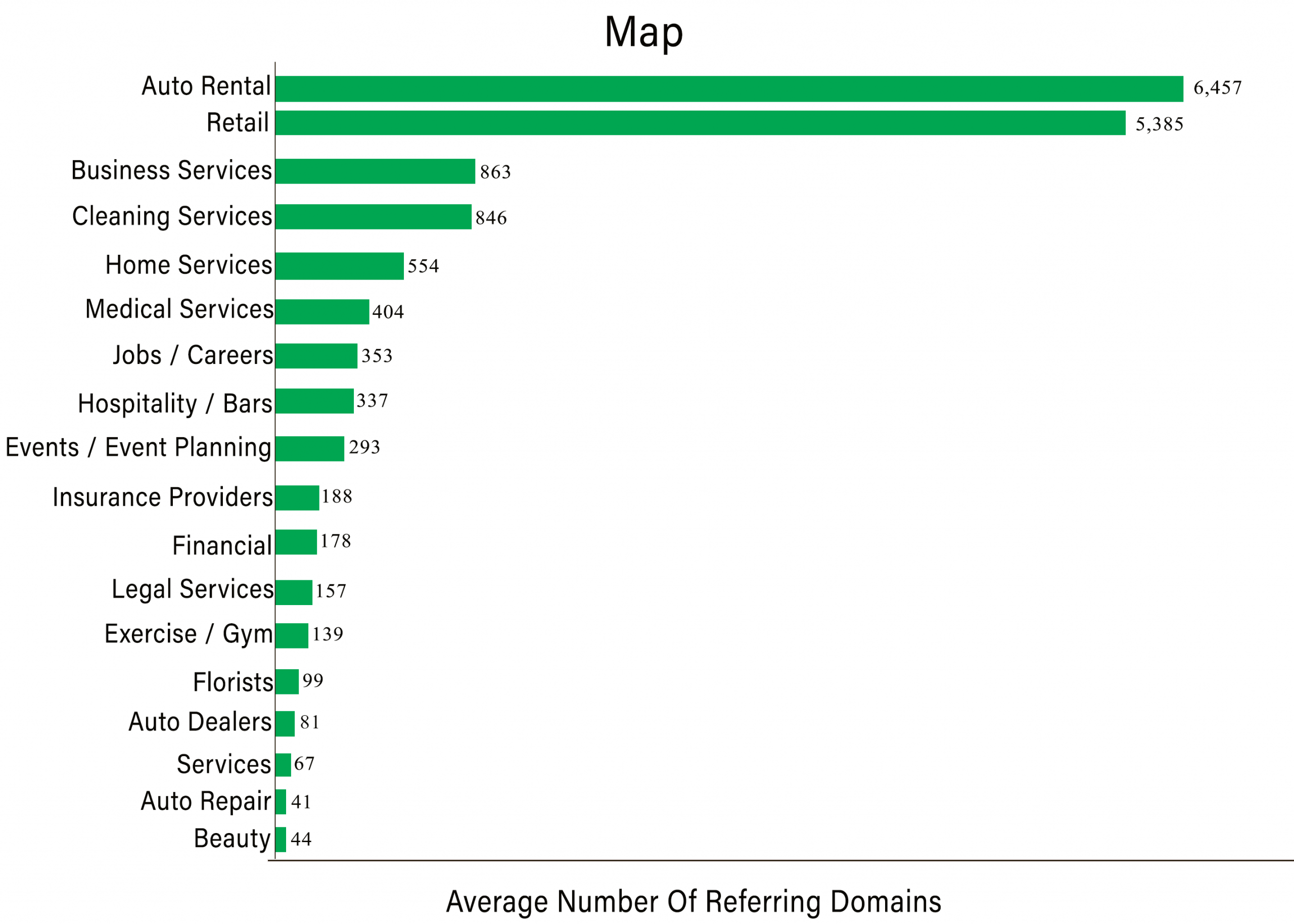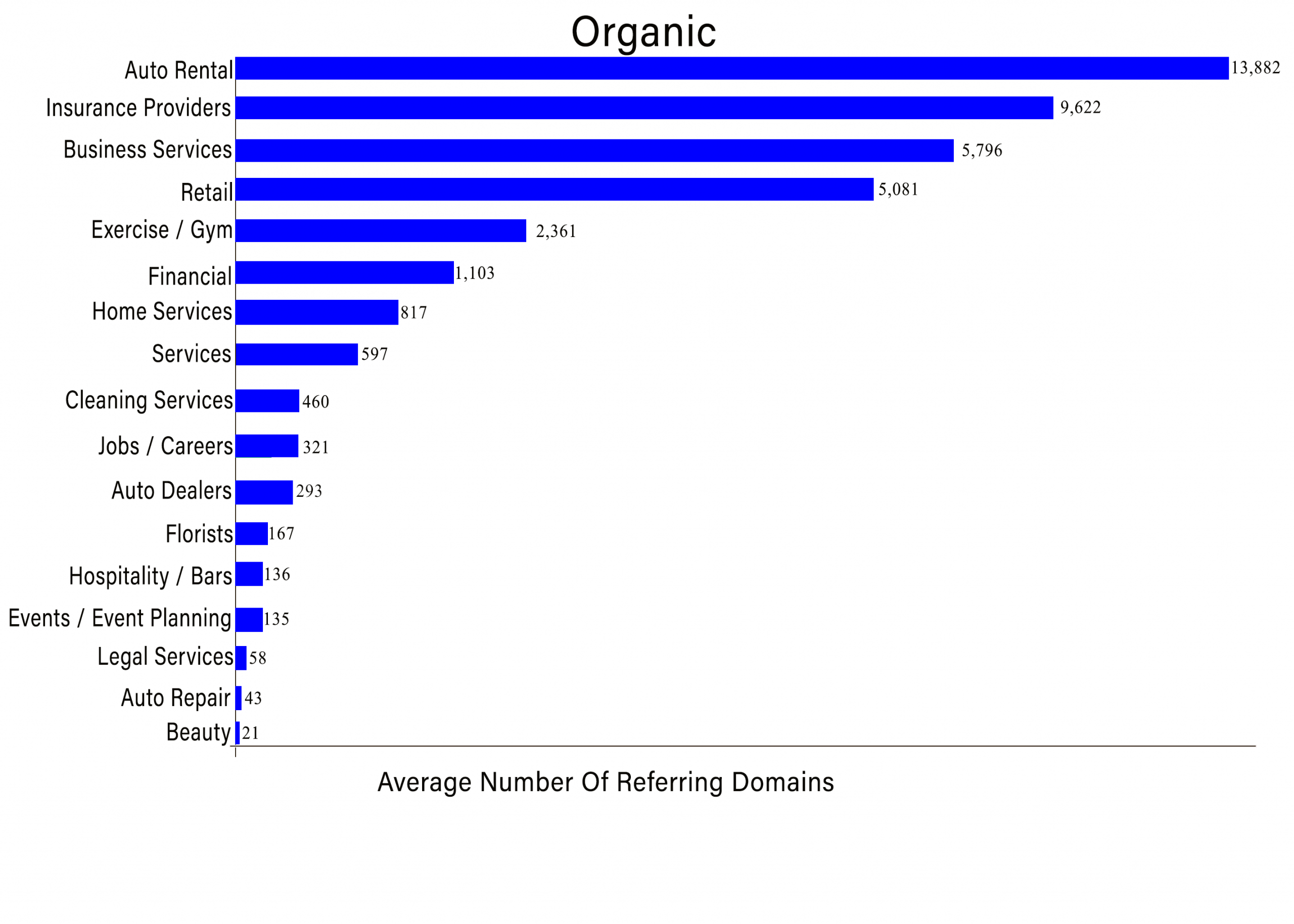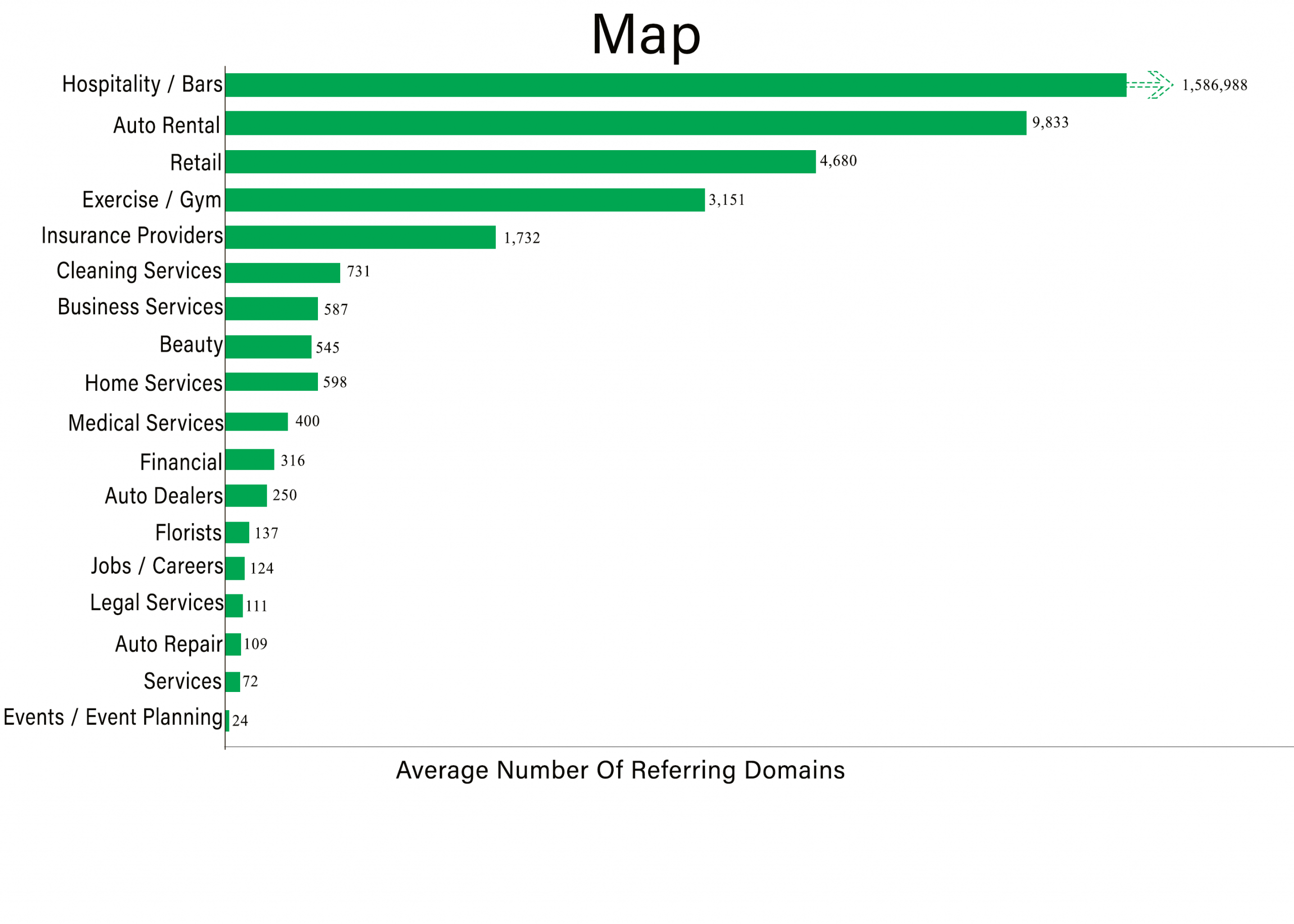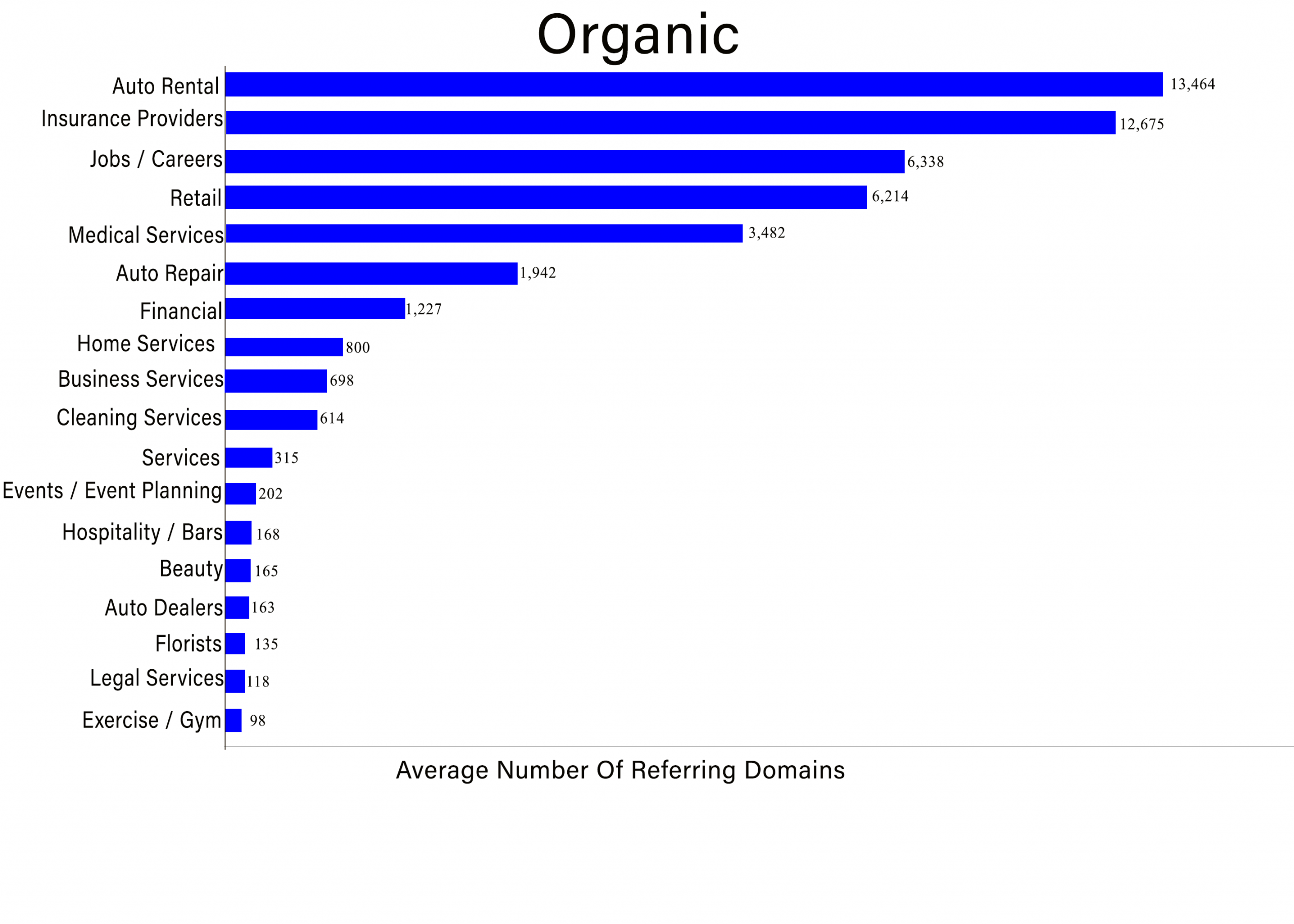As an SEO I’ve spent years telling clients, bosses, colleagues in related fields, packed rooms at conferences, my mom, college kids, friends, significant others, random people in grocery stores, newborn babies, people stuck next to me on a plane, and pretty much anyone who will listen or is trapped talking to me – that counting the number of links or linking websites pointing to a website is not a great measurement of how well a website’s SEO is doing. Even though it may help to understand how well a program is doing and having more links or linking websites (referring domains) is often a good thing, the number itself may not indicate that a website will or won’t rank highly in Google for specific queries.
Up until now when I’ve been asked “How many links does my website need to rank #1 in Google?” or “How many links will it take for my website to rank at the top of Google” my answer has always been “As many as it takes”. That has now changed and I can at least give some guidance to clients based on their industry and if they want to rank in Organic or Maps. For the past two years my team and I have been researching keywords that have relatively high search volume in a variety of industries where the query has local intent and the business has a physical pressence in some form in a city or region.
Results
So how many links do you need? Below you’ll see graphs showing the Average Number of Referring Domains (linking websites) that you might need in the industries we examined.
Number of Linking Websites required to rank as the top local business in Google Local / Google Maps – 2018 by industry.
- Auto Rental – 6,457
- Retail – 5,385
- Business Services – 863
- Cleaning Services – 846
- Home Services – 554
- Medical Services – 404
- Jobs / Careers – 353
- Hospitality / Bars – 337
- Events / Event Planning – 293
- Insurance Providers – 188
- Financial – 178
- Legal Services – 157
- Exercise / Gym – 139
- Florists – 99
- Auto Dealers – 81
- Services – 67
- Auto Repair – 41
- Beauty – 44
Number of Linking Websites required to rank as the top local business in Google Organic Search – 2018 by industry.
- Auto Rental – 13,882
- Insurance Providers – 9,622
- Business Services – 5,796
- Retail – 5,081
- Exercise / Gym – 2,361
- Financial – 1,103
- Home Services – 817
- Services – 597
- Cleaning Services – 460
- Jobs / Careers – 321
- Auto Dealers – 293
- Florists – 167
- Hospitality / Bars – 136
- Events / Event Planning – 135
- Legal Services – 58
- Auto Repair – 43
- Beauty – 21
- Medical Services – null
Number of Linking Websites required to rank as the top local business in Google Local / Google Maps – 2019 by industry.
- Hospitality / Bars – 1,586,988
- Auto Rental – 9,833
- Retail – 4,680
- Exercise / Gym – 3,151
- Insurance Providers – 1,732
- Cleaning Services – 731
- Home Services – 598
- Business Services – 587
- Beauty – 545
- Medical Services – 400
- Financial – 316
- Auto Dealers – 250
- Jobs / Careers – 124
- Florists – 137
- Legal Services – 111
- Auto Repair – 109
- Services – 72
- Events / Event Planning – 24
Number of Linking Websites required to rank as the top local business in Google Organic Search – 2019 by industry.
- Auto Rental – 13,464
- Insurance Providers – 12,675
- Jobs / Careers – 6,338
- Retail – 6,214
- Medical Services – 3,482
- Auto Repair – 1,942
- Financial – 1,227
- Home Services – 800
- Business Services – 698
- Cleaning Services – 614
- Services – 315
- Events / Event Planning – 202
- Hospitality / Bars – 168
- Beauty – 165
- Auto Dealers – 163
- Florists – 135
- Legal Services – 118
- Exercise / Gym – 98
Changes from 2018 to 2019 for Ranking #1 in Google Maps / Google Local
The biggest change in number of referring domains required to rank as the top local area business on Google Maps / Google Local between 2018 and 2019 happened in the Hospitality / Bars industry where the average number of linking websites to rank as the top local business went from 337 to 1,586,988 a change of +1,586,651. This is because some businesses in this category began using Facebook as their website (and/or Google began ranking business listings at the top with Facebook pages as a website).
In terms of independently hosted websites the Auto Rental industry had the largest increase in average number of referring domains which went up by +3,376.
Other industries that gained in the average number of linking websites needed to rank as the top business between 2018 and 2019 were:
- Exercise / Gym +3,012
- Insurance Providers + 1,544
- Beauty +501
- Auto Dealers +169
- Financial +138
- Auto Repair +68
- Home Services +44
- Florists +38
- Services +5
Not all industries we tracked became harder in terms of average number of linking websites needed to rank at the top of Google Local / Google Maps. 7 different categories had a reduction in average number of referring domains between 2018 and 2019:
- Retail -705
- Business Services -276
- Events / Event Planning -269
- Jobs / Careers -229
- Cleaning Services -115
- Legal Services -46
- Medical Services -4
This drop could be due to Google trying to show nearby businesses more in this type of search, new businesses operating in these industries, or of course changes to the link index used to measure (Majestic). Surprising out of all of these was the minimal decrease in Legal Services and the slight decrease in Medical Services. We also theorize that these changes could be due to business in these segments cleaning up their backlink profiles.
Changes from 2018 to 2019 for Ranking #1 in Google Organic Search
Google’s top local business listing in Organic Search appears to have become more competitive in 2019 as more and more of the listing space is dominated by business listing websites such as Yelp, ZocDoc, Justia, and Home Advisor and as Google pushes organic results further down the page making it more difficult for users to find with their fancy layout changes, more ads, and bigger less-useful local business listings. To combat these changes we’ve seen some categories become increasingly aggressive such as Insurance Providers with an increase of average linking domains required to rank as the top local business of +3,053, Auto Repair with an increase of +1,899, and Retail with an increase of +1,133. A total of 9 industries we tracked appear to have gotten more competitive in terms of average required referring domains needed to rank as the highest local business in Google’s organic listings.
Here’s the full list:
- Insurance Providers +3,053
- Auto Repair +1,899
- Retail +1,133
- Financial +124
- Cleaning Services +154
- Hospitality / Bars +32
- Events / Event Planning +67
- Legal Services +60
- Beauty +144
Another curiosity we discovered while examining Google’s Organic Search listings for local queries is that if a business listing website or an aggregator listing is present at the top of the results, the first local business that is listed is often not one we’d expect to see usually being of low or mediocre quality, having more spammy inbound links than competitors, being rarely updated or out-of-date, using exact match domains, and just in general being a site we’d typically expect to see on page 2 or lower. It’s almost as if when the algorithm determines it wants to use a list of local businesses from another website, it gives up on many ranking factors typically applied for local business websites. This is anecdotal to be sure but makes business sense. If most users click the first one or two organic listings and those are high-quality lists from known publishers, then why use more computation on the rest of the list as long as the businesses being listed are in the right industry, local, and real. Of, course Google might also be trying to provide some diversity giving a business with little visiblity in the lists a placement as their top local listing, this research didn’t dive into that and this anecdote is only being provided to try and help explain some oddities in the Google Organic Search local query results. Home Services, Services, and Auto Dealers appeared to be the most impacted by this trend. While the same held true in Legal Services, Events / Event Planning, Beauty, and Hospitality / Bars those industries saw increases in the average number of linking websites required to rank as the top local business.
Some surprising drops included Auto Rental -418, Auto Dealers -130, and Home Services -17. As explained earlier these drops could arise from a variety of different reasons including changes in the link index used in this research over the time-period (Majestic), link profile clean up to remove bad links by websites, adjustments to Google’s algorithm, etc…
Full list of industries that had a decrease in the average number of linking websites required to be the top ranking local business listing in Google’s Organic Search results:
How to use this data
This data might be useful to you if you’re a local business or an agency trying to understand how many linking websites to aim for to reach your ranking goals. As noted earlier more websites linking than listed doesn’t mean you’ll rank highly or quickly and fewer linking websites doesn’t mean you won’t rank highly or quickly either. Use this as a rough target only and to set reasonable expectations.
For example if you want to start your own independent car rental company, you’ll have a steep hill to climb in terms of rankings as the map and local organic results were dominated by these companies who continue to invest in their link building, content marketing, and SEO. By seeing this you should take a more diversified approach including paid advertising and referrals while investing in you own SEO.
If you rank as the top local business but you rank lower than Yelp, Justia, etc.. that doesn’t mean you should stop trying. There is evidence that Google may rank a local business in the Organic Search results higher than listing sites or aggregators overtime and with fewer total inbound linking websites than those. If you rank as the top local site but with fewer than the above mentioned average number of referring domains, then it is likely that: A – your links are of higher quality, B – The market you are in is smaller, C – The competition in your local market is different.
If you have close to the number of average linking websites for your industry as mentioned above and you are not ranking well in the maps or organic it could be due to another issue such as low quality links, a manual penalty, a Google algorithmic demotion like Panda or Penguin, Your location is too close to a similar business, your NAP data isn’t correct across the web, etc… Contact an SEO and ask them for an Audit or a brief review to see how to fix this.
Methodology
We used various keyword tools including Keyword Guru to discover some of the most searched for queries for business and services in the city of Dallas. We used Google’s Keyword Planner Tool data to determine average monthly search volume.
Each keyword selected had to include ‘Dallas’ for this test.
We examined the top rankings for highly searched for keywords in the following industries; Auto Dealers, Auto Rental, Auto Repair, Beauty, Business Services, Cleaning Services, Events / Event Planning, Exercise / Gym, Financial, Florists, Home Services, Hospitality / Bars, Insurance Providers, Jobs / Careers, Legal Services, Medical Services, Retail, Services.
We looked at the number of links and the referring domains for the top ranking local website using Majestic’s database.
A top ranking local website was considered a website that had some form of local presence, non-local businesses that ranked were not counted. (i.e. Indeed.com for jobs, Yelp, AngiesList, Home Adviser, etc…). Some large businesses were considered local including Macy’s, Dick’s Sporting Goods, GEICO, chain restaurants, and others because they offer a local physical presence and staff.
This study examined the highest ranking local website for each query. This means that if a non-local business was number 1 and a local business website was number 2, then we examined the local business website at position number 2.
This study did not account for or include other Google features such as Ads, Local Ads, Shopping Ads, AMP / News carousel, Answer box, “People also Ask”, or other features that might displace, replace, or obscure the organic rankings.
The study examined Local Map Pack rankings and Local Organic rankings for each query. We defined these as such:
Local Map Pack rankings – When a Google map with 3 or fewer business listings appeared anywhere in search.
Local Organic rankings – Traditional blue link results in Google must be a business website (or in rare cases a social media profile when the business has no website).
Some local intent queries did not trigger a map listing, some triggered a single business listing in the knowledge panel on desktop (right hand side). These were not counted.
Businesses who use Facebook pages as their website were allowed and link data was gathered for Facebook’s root domain. (This was most common with nail salons and bars and may skew data for the ‘Beauty’ and ‘Hospitality’ industries)
Some chain websites use a subdomain to list their location information and build pages for each location. These pages rank in both the map and organic listings. Linking data was gathered from their subdomain, not the root.
Some industries are broken out (i.e. Auto Dealers vs. Auto Rentals) and others are more combined (i.e. Business Services contains Accounting, Marketing, PR, SEO, etc..)
Caveats
There are a lot of caveats to this type of research and to this study in general. Here are the biggest ones
- I do not know Google’s algorithm or precisely how they treat inbound links.
- I do not know how Google decides to apply value to or not apply value to a link or ignore it all together.
- The link index used (Majestic) changes over time and does not equal the same index Google uses.
- The websites ranking at P1 for a specific query for me may not be the same that ranks for someone else. I attempted to control for this by using a different browser and being logged out of Google to try and see the results fresh but there is no guarantee that I was able to stop any personalization.
- Physical location plays a big role in how Google ranks websites today and to control for this the searches were always performed from the precise same physical location. However, the ISP used changed between 2018 and 2019’s data pull and might have had an impact.
- Businesses open and close locations all the time which could have impacted their rankings and therefor impacted the linking website numbers.
- The data was collected manually by human by hand which might have lead to errors. I double and triple checked the work and had my team members check it as well to ensure accuracy, but some small errors might have escaped discovery.
- The data collected represents only a snapshot over the course of a few days in both 2018 and 2019 and does not represent the entire year which could lead to sample bias.
- Sample bias might also be introduced because data was collected only in the urban area of Dallas, TX. Google may use signals different in different types of geographic regions and different countries which would cause the data to be skewed by the location.
- I did collect a sister-set of data for a smaller nearby city, but did not include that data in this post.
- The keywords used to find website’s which ranked highly were modeled after estimates in Google Ads’ Keyword Planner tool for the highest volume search keyword including the word ‘Dallas’. This tool constantly changes how these figures are calculated and those keywords may not represent how customers find your business in your local area which could lead to data skewing due to factors such as exact match domains.
Final Warning About This Link Data
Do not use this data to expect to rank #1 in Google for any keyword. It should only be used as a goal to achieve links from quality websites in hopes of ranking highly and to track your progress in that direction. It may also be used to help understand your competitive landscape better or diagnose potential ranking problems related to links.
If you’re considering using this data I would recommend instead performing your own SEO Audit or having one performed for you. Always consult with an experienced professional SEO before using data like this to make important business decisions.
FAQ’s
Question: Will this study be repeated in the future?
Answer: This is an annual local linking study for local SEO and will be reproduced again in 2020. Future versions might add more geographic regions and may change to use a mobile device for searching to better reproduce user experiences and real-world outcomes.
Question: Are the number of links included total links or are these all dofollow links?
Answer: The linking websites / referring domains cited are root domains linking to a website in total, I did not collect only dofollow links or only those I believed were of quality.
Question: So if I get more websites to link to me than the average listed for my industry I will rank #1 in Google?
Answer: No, all links are different and carry different values and those values change over time either due to internal forces at Google (i.e. algorithm changes) or external forces (i.e. more links added to the page). This study doesn’t examine those signals, quality, anchor text, or various other SEO factors. This study also examined the top ranking website for a local query, which means even if getting that many websites to link to you made you the top ranking local website you might still get outranked by Yelp or other sites.
Question: Why did you do this study if it doesn’t matter?
Answer: I wouldn’t say it doesn’t matter. Knowing the volume of inbound linking websites / referring domains can be very useful and measuring progress in growing that number with an eye on quality can be equally as useful to help a client understand progress and potential future outcomes. That being said it also gives me a chance to investigate the SERPs manually and uncover oddities in them that might otherwise go unnoticed.
Question: Are you recommending that I track the number of linking websites as a KPI?
Answer: We do, yes. If you have to report to your superiors about link building it helps to know that overall number. I would recommend to report on Sales, Leads, Calls, and Traffic more so though if you have limited time or space for reporting. We track inbound link data for our clients across 3 tools once per month to gauge growth in our link building and content marketing efforts (and to get early warnings on negative SEO attacks).
Note: Medical Services for 2018’s Organic Search data is listed as Null as the data somehow missed the charts and calculations stage. The data was collected and this post will be updated once that data has been added.




